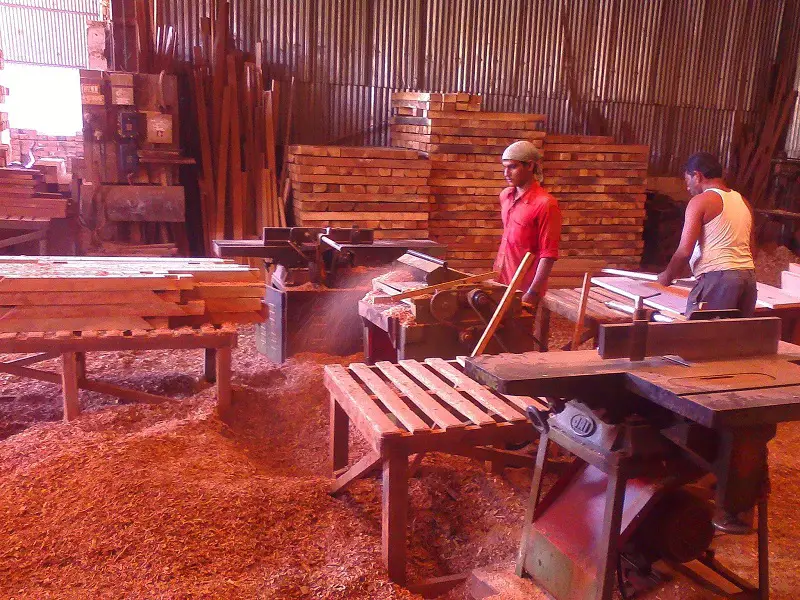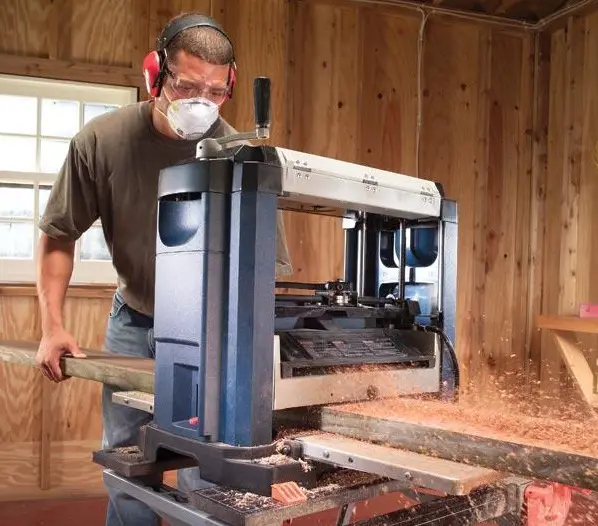I chose this topic at the suggestion of a friend of the magazine whose health has been impaired because he spent a long time in an environment contaminated with wood dust. The topic was challenging, so I started documenting it. I found a lot of material about health problems caused by wood dust, and the problems also occurred because of compounds in wood, not just the dust itself. I have tried to synthesise all this information and the result is below.
Sources of wood dust
Woodworking is inconceivable without sawdust and wood dust. No matter how efficient the dust extraction system is, it will still exist. All machines that cut, mill and drill wood or wood-based panels are also sources of dust even if they have dust extraction systems.
Dust also occurs in wood or panel sanding processes. The most harmful is hand sandingand if the sander does not wear a mask, the risk of respiratory problems developing over time is very high.
A big problem is also the dust reintroduced into the system. This is the accumulated dust that is cleaned by processes that allow it to return to the workshop atmosphere. Specifically, when cleaning in the workshop or department, no wet cloths or vacuum systems are used, but it is simply removed from the places where it was deposited. It then gets back into the air and is breathed in by those working there.
Allergies and problems are studied with the idea that the dust comes from chemically untreated wood. If it is processed, the risk of substances to which the body reacts negatively increases. This is the case with biocide-treated wood (wood used outdoors) or wood-based panels.

What the consequences of prolonged exposure to wood dust can be. How this dust works
There are three ways dust works on woodworkers:
- as solid particles that enter the nose, throat and lungs through breathing, direct contact with the skin or in the eyes;
- through the chemical compounds present in the different wood species;
- by bacteria, fungi and mould in the wood.
Solid particlesof wood dust can cause skin and eye irritation, difficult breathing, dry and sore throat. Over time dermatitis, allergies, conjunctivitis, bronchitis or rhinitis may occur. Long-term exposure to dust can lead to occupational diseases.
The big problem is particles below 0.3 microns that are not retained by filters, even High Efficiensy Particulate Air (HEPA) filters. They end up being absorbed into the body through the skin or lung walls and cause immunological reactions. Hypersensitivities of the lungs can occur only during working hours and symptoms can easily be mistaken for flu or cold.
Chemical compounds in wood can be very different. The fact that more and more exotic wood is now being worked with is the reason why various forms of woodworking allergies are appearing. Some of the chemical compounds in wood are not even identified yet. Wood develops them as an adaptation to the environment in which it lives, to protect itself from local insects or to be more resistant in those weather conditions. These compounds are more concentrated towards the interior of the wood and therefore secondary processors are more exposed to diseases and allergies than primary processors.
But not all chemical compounds are unknown. Species belonging to the same classes have the same aggressive compounds even if they grow in different areas. For example, there are various species of rosewood or ebony that, even though they grow in different places, develop the same aggressive chemical compounds. Red cedar is another aggressive species, one of the most chemically aggressive. But also species that grow here, such as nuc or maple, contain compounds that can cause allergies. To give you an idea here a list with wood species from all over the world and the problems they can cause.
Contact dermatitis, decreased lung capacity, pulmonary hypersensitivity or asthma as an occupational disease may occur following prolonged contact with chemical compounds in such wood species.
Often it is not the dust or chemical compounds in wood that cause allergies or respiratory illness but mould, bacteria and fungi that grows on or in wood. It is recommended to use healthy and dry wood according to its subsequent use. If signs of micro-organism infestation are found, it is best to avoid skin contact and to use protective equipment for hands, nose and mouth.

Controlled exposure lowers the risk of disease
As I said, it is impossible to have a totally dust-free environment when working in woodworking. But steps can be taken so that there are as few unpleasant consequences as possible. Here are some of them:
- installation of high-performance exhaust systems in sections and workshops;
- the use of HEPA filters in exhaust systems to remove even the finest dust particles;
- purchase of tools and machines with dust-absorbing systems;
- information on the species of wood used and its replacement when it presents a high risk of disease;
- choosing, where possible, designs that involve fewer dust-generating operations;
- use of sharp tools. Tools that are not properly sharpened or maintained generate more dust;
- maintaining cleanliness in wards and workshops. Use methods that do not allow dust to re-enter the system: wet cleaning, vacuuming of dust; daily cleaning so that dust does not accumulate;
- avoiding the use of compressed air to remove dust resulting from processing. Replace it with suction systems;
- use of protective equipment equipped with gloves and masks with high-performance air filters;
- inform yourself about the risk of using certain exotic species. Study safety data sheets and attend seminars on these topics.

Dust extraction systems, machines and tools with dust extractor
The way you can reduce as much as possible the wood dust in the air and therefore the risk of illness is to purchase exhaust systems that remove it from the workspace. These need to be fitted with high performance filters that allow as much dust as possible to be retained in the smallest possible size. This will release cleaner air into the workplace or atmosphere and reduce the risk of allergies and respiratory problems.
And machines equipped with suction nozzles right next to the cutting, drilling or milling tool are a very good investment. The immediate absorption of the dust and sawdust generated also extends the tool life, which is another great advantage.
Sanding is a great dust generator, both wood and varnish. While machines are equipped with powerful vacuum cleaners, the same is not true for manual sanding. This is usually done in the workshop and dust removal is left to the exhaust system. A good investment in this case would be special sanding tables equipped with a dust extraction system. Dust is removed as soon as it is generated, greatly reducing the risk of illness. I was once in a furniture factory in Bulgaria. They were making special chairs for children for a Danish company. They did a lot of sanding by hand, but the dust was almost missing from the production area, which was quite large. All the 15-20 tables where sanding was done were equipped with vacuum systems. The atmosphere in the hall was clean and the women sanding were not dusty from head to toe.

In conclusion
Don't overlook the wood dust in the workshop on the grounds that in the past carpenters didn't have exhaust systems and nothing happened to them. In the past there were no such tools generating increasingly fine dust, and carpenters' bodies were not weakened by processed foods and an environment increasingly full of noxious fumes. Nor were they working with species brought from the furthest corners of the world.
There are also regulations on the amount of dust allowed in the working environment. The General Labour Protection Regulations stipulate in Annex 32 a limit of 5 mg dust/m³ air for both hardwood and softwood, but only 0.5 mg/m³ for cedar.
We live in a time when allergies are increasingly common and unexplained body reactions are always occurring. A clean working environment can save us from further discomfort or even occupational illness. It is good not to ignore this.
Good luck at work and take care of your health!
































Yes, thanks for the info